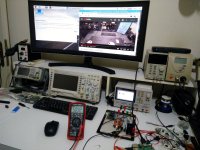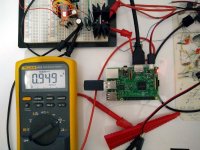In my experience they are not that weird. I believe that the problems might be caused by voltage drop on the cables / connectors. It might be a good idea to bump up the voltage to ~5.2V on the UBiB's output in order to compensate for any voltage drops. The RPi won't mind the (potentially) slightly higher voltage.
The RPi definitely does not need mains ground. It is designed to be powered by a cheap non-grounded smps.
That caution about parasitic voltage drops sounds logical. The SMPS adapters usually measure higher than nominal before loaded indeed.
Bring over the RPI if you can so we will be able to see what is going on with its PSU requirements and settings. I have already tested the breadboard L-Adapter loaded with a TS100 soldering iron and a 40+40W SMSL amp on 4Ω speakers with success.
Attachments
I read that RPI3 main voltage range is between 4.75V and 5.25V.
Below 4.75V the red power led will go out.
I am perplexed that mine worked for an hour only.
I will try to find a special USB cable-with independent external 5V supply....for testing later.
(Also a few people claim that the separate USB 5V gives less interference thus better SQ)
Below 4.75V the red power led will go out.
I am perplexed that mine worked for an hour only.
I will try to find a special USB cable-with independent external 5V supply....for testing later.
(Also a few people claim that the separate USB 5V gives less interference thus better SQ)
Put the voltage meter at the RPI's power input. So to monitor the situation. Maybe it's drift, maybe it's drop, maybe it's both.
I love to visit both of you ;-)I will indeed be paying you a visit tomorrow.. Bearing a Pi.. 😛
Warms the heart to see the L-Adapter in action. Press on....
By the way, you said it was capable of 'several amperes' - would that stretch to 5 or 6A? Have a NAS which is a prime candidate (as it's my music library) for the L-Adapter and whose wallwart sez 5.4A. Although the actual spec online says 25W (at 12VDC) while accessing the HDDs so it might not need to stretch quite to 5+ amps.
EDIT: Dimdim, I am surprised you didn't use that breadboard to listen to the Pi. Or did you....?!
By the way, you said it was capable of 'several amperes' - would that stretch to 5 or 6A? Have a NAS which is a prime candidate (as it's my music library) for the L-Adapter and whose wallwart sez 5.4A. Although the actual spec online says 25W (at 12VDC) while accessing the HDDs so it might not need to stretch quite to 5+ amps.
EDIT: Dimdim, I am surprised you didn't use that breadboard to listen to the Pi. Or did you....?!
I did a little stress test. I put the meter in series between the PSU and the RPI3, then booted it and tried to throttle it with two media streams playing along. Live web TV and an HD movie trailer on YouTube. Used Wi-Fi. No storage peripherals. Just an old wireless keyboard & mouse receiver stick. It showed up to 95% CPU and did few frames & audio hick ups. 0.95A was caught by the Fluke's min max function. After shutdown it still pulls circa 110mA.
Maybe it bursts for even more current faster than the Fluke can catch? Maybe. But it never reset or did anything funny like freezing the OS. The 38mm tall board level sink stood quite nicely for 3V Vin-Vout difference (8Vin 5.1Vout).
Maybe it bursts for even more current faster than the Fluke can catch? Maybe. But it never reset or did anything funny like freezing the OS. The 38mm tall board level sink stood quite nicely for 3V Vin-Vout difference (8Vin 5.1Vout).
Attachments
Suspect the Fluke did what Flukes do - worked properly. Read somewhere that, without loading it down with periperals, the 3B runs at around 700mA.
EDIT: isn't that a Siglent SPD3000-series power supply in the background of one of the earlier images? Don't they have a software feature which does logging? You could try the RPI on that.
EDIT: isn't that a Siglent SPD3000-series power supply in the background of one of the earlier images? Don't they have a software feature which does logging? You could try the RPI on that.
Last edited:
During boot it recorded 598mA max, when not pushing it but opening media and forum windows it hovered higher pushing around 700mA. Occasionally 750mA. I used the latest official Raspbian Stretch Nov 2018 OS.
EDIT: isn't that a Siglent SPD3000-series power supply in the background of one of the earlier images? Don't they have a software feature which does logging? You could try the RPI on that.
Yes, its a 3303S. It actually has a timer programmable output function, not a logger.
Has a "waveform" chart function instead which is silly, does squat jaggies but it does not record numbers, not even has numbered dents across the XY. The Fluke is faster also I believe. It now caught a 0.679A during the boot in min max mode. But the supply never displayed more than 0.56A during that. Lost it between updating digits. So that is why they mentioned 700mA.
Interesting. I guess the 2.5A power supply recommendation must be for a fully tricked-out Pi. Never had the red light go out using a linear 1A supply - but then I only use it as a music server - Moode.
Was looking at the Siglent 3000 series awhile back - seemed a decent value for the dollar for a triple supply. Still haven’t decided - what’s your take on it? Apologies for the off-topic.
Was looking at the Siglent 3000 series awhile back - seemed a decent value for the dollar for a triple supply. Still haven’t decided - what’s your take on it? Apologies for the off-topic.
Good for the price, compact & quiet enough, still it belongs to the mediocre bench PSU category in general. But not many decent choices there. The cheaper model with two digits after the dot resolution is enough.
Hello Salas,I did a little stress test. I put the meter in series between the PSU and the RPI3, then booted it and tried to throttle it with two media streams playing along. Live web TV and an HD movie trailer on YouTube. Used Wi-Fi. No storage peripherals. Just an old wireless keyboard & mouse receiver stick. It showed up to 95% CPU and did few frames & audio hick ups. 0.95A was caught by the Fluke's min max function. After shutdown it still pulls circa 110mA.
Maybe it bursts for even more current faster than the Fluke can catch? Maybe. But it never reset or did anything funny like freezing the OS. The 38mm tall board level sink stood quite nicely for 3V Vin-Vout difference (8Vin 5.1Vout).
Is possible to measure the rpi3 headless with hdmi disable, no screen, mouse , keyboard, and wifi?
Only ethernet...
I use it as a music player like that with volumio, or picoreplayer or max2play . I use a nas or pc to store music files.
Tks.
EDIT: Dimdim, I am surprised you didn't use that breadboard to listen to the Pi. Or did you....?!
That wouldn't be fair to the L-Adapter, with it being on a breadboard and all.. 😛
I'm sure Salas can arrange for such tests when the pcb prototypes start rolling in.. 😀
Hello Salas,
Is possible to measure the rpi3 headless with hdmi disable, no screen, mouse , keyboard, and wifi?
Only ethernet...
I use it as a music player like that with volumio, or picoreplayer or max2play . I use a nas or pc to store music files.
Tks.
That's the way Archphile, my distro of choice, is set up to run by default.
Such a configuration has very low power consumption, definitely less than 500mA.
- Home
- Amplifiers
- Power Supplies
- Salas SSLV1.3 UltraBiB shunt regulator




